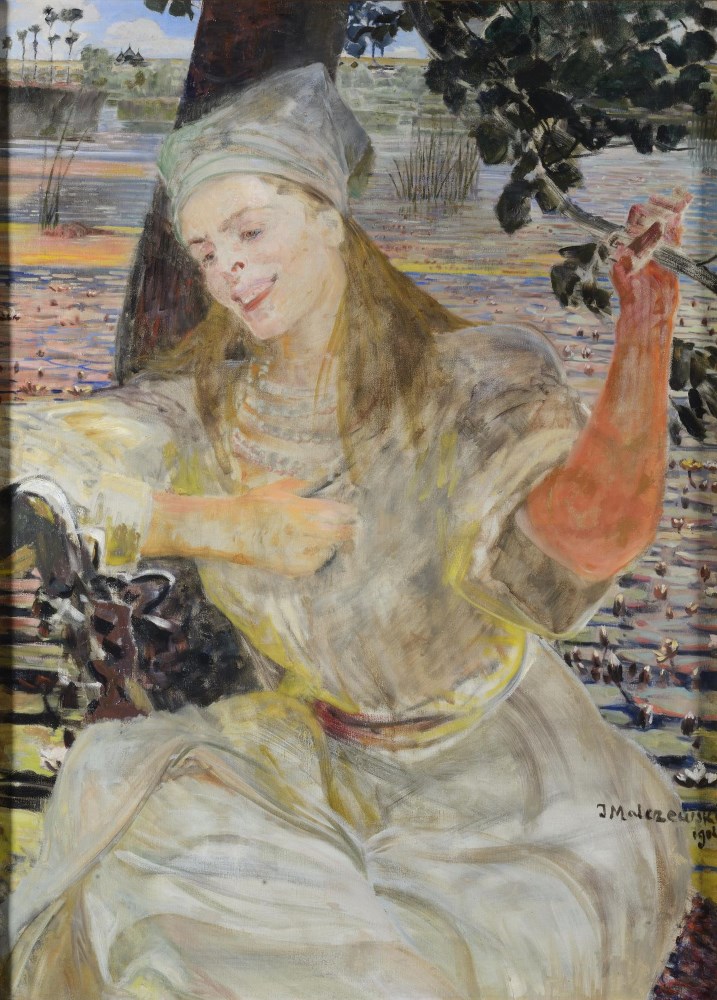Description:
Jack Malczewski (1854-1929) had a great love for art and romantic literature, particularly the poetry of Juliusz Słowacki, which he inherited from his family. He came from a szlachta family, albeit not wealthy. His father Julian supported him in his artistic career. The events of 1863, the January Uprising and subsequent repression, left a special mark on the young artist. His first teacher was Adolf Dygasiński. He spent his teenage years between 1867 and 1871 at the Karczewski family manor in Wielgia. In 1873 he started studying at the Academy of Fine Arts in Krakow under the tutelage of Jan Matejko. He was also a student of Władysław Łuszczkiewicz. He studied at the École des Beaux-Arts in Paris and traveled to Italy, Vienna, Munich, Greece and the Minor Asia. Between 1896 and 1900, and then again in 1910-1914 he was a professor at the Academy of Fine Arts in Krakow. Between 1912 and 1914 he was rector of the Academy. His early works were idealized realism, followed by naturalism. The predominant theme of his works from this period was the fate of exiles in Siberia and the inspiration of Juliusz Słowacki’s “Anhellim”. At the same time, fantastic and allegorical interpretations began to appear in Malczewski’s work. After his father’s death in 1884, the recurring theme in Malczewski’s work was Thanatos, the god of death. After 1890 his art became completely symbolic. Works manifesting the turn towards the symbolism style are: “Introduction” (1890), “Melancholy” (1890-1894), “Vicious Circle” (1895-1897). The artist tackled existential, historical and artistic topics, interweaving ancient and biblical motifs with local folklore and the essential Polish landscape in his works. Form, color, monumentality of his presentations and their expression became his trademarks.
Description of the painting:
“Woman Study in a Tree” is a portrait of Maria Balowa. Around 1904, figures of his beloved and muse began to appear more and more in Jacek Malczewski’s works. The developing feeling between them was preserved in partially preserved correspondence, poetic works and numerous paintings made public and those that remained forever in the “Tuligłówka sketchbooks”. Balowa was portrayed in an intentional setting. The symbolism of water and water lilies emphasizes the beauty and youth of the model and the inappropriateness of the existing bond between the lovers.
Looking far away or into themselves
And when love unfolds in them
I kneel and bury myself in dust
Your lips are the gateway to pleasure
A white spark of coral blood
When you laugh openly and honestly
A string of pearls thrown on a pink background.
Your golden hair – golden hair […]”In one of his poems, Jacek Malczewski* describes his beloved. His fascination with her lasted for several years.
In the summer, the painter visited the Balow Manor in Tuligłowy, Ukraine. A pavilion-studio was built especially for him in the garden. Most likely, the artist created the work discussed today in September 1904, as part of the so-called “sketchbooks” of Tuligłowy. Balow* mentions the artist’s stay at the Ukrainian manor in one of his letters.
In the foreground we see a woman dressed in a light and airy white, presumably still summer dress. Her neck is adorned with strings of white pearls. The free relationship between the portrayed and the portraitist is testified by the unbuttoned, delicately falling on the shoulders of the model’s hair, a wide smile of open lips, a head covered with a white scarf and a leg crossed over a leg. The woman sat down on the edge of a pond or lake. She placed her right hand on the back of the bench, pressing her palm to her chest. Her left hand holds a branch of a tree, in the shade of which she hid. Her gaze does not meet with the viewer, or with the artist, far beyond the visible to us scene.
The day is drawing to a close. The orange sun is reflected in the sheet of water painted in the background of the scene and on the white dress of the woman. The play of light and shade accentuated by the branches of the tree is fully conveyed by the artist. The figure of the model looks sketchily outlined. On the other hand, the details of the view spreading behind her are worked out. The contours of a wooden building in the distance, reeds, trees and countless water lilies covering the surface of the water appear.
The symbolism of water lilies, or white blooms, is not entirely obvious. They have captivated the imagination and creativity of one of the greatest impressionists – Monet, only a few years earlier. They fascinated with their appearance and their vital strength. Ancient beliefs attributed water lilies or baths in the water where they grow almost miraculous properties, providing beauty and smoothness of the body. Standing, calm water has calming and life-giving properties. The combination of the female figure with the water surface evokes associations with beauty and the Greek goddess of love – Aphrodite, who was supposed to emerge from it at the moment of her birth. However, water very often becomes a “mirror with a depth” in which one can discern hidden character traits. As one of the most noble elements, it is recognized as a mirror of the soul. It was also a tool of judgment and disclosure of guilt, and both Maria Balowa and Jacek Malczewski struggled with it throughout their relationship. The embodiment of youth, beauty, grace and intelligence – a muse, whose face we can find on dozens of the painter’s works, here is presented in a more intimate, inaccessible, as if forbidden to the eyes of the uninitiated.


